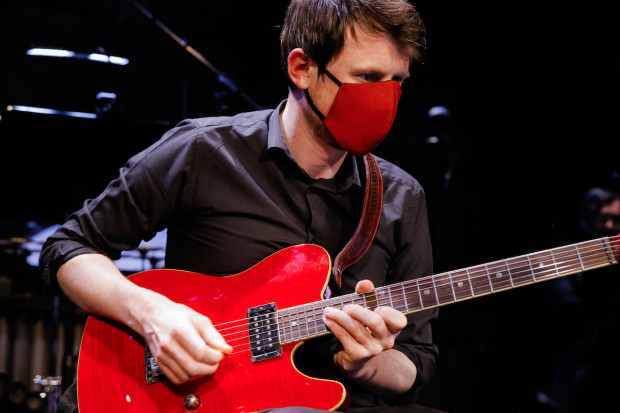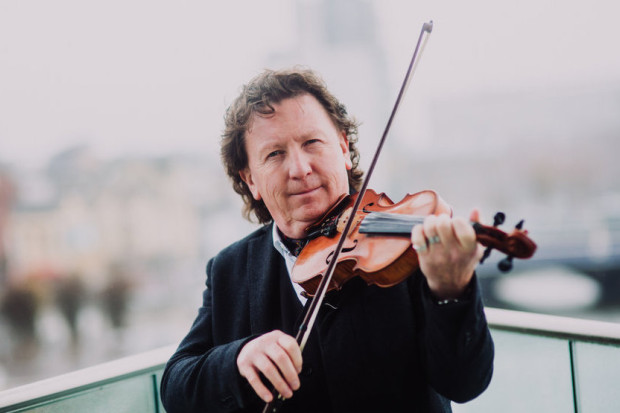
Eoghan Ó Ceannabháin and Ultan O’Brien
The Interplay of Light and Dark
Solas an Lae is a new album of songs and tunes from two Dublin-based musicians, Eoghan Ó Ceannabháin and Ultan O’Brien. Ó Ceannabháin comes from a family of sean-nós singers (namely his father Peadar and his sisters Saileog and Muireann) and also plays flute, concertina and whistle. O’Brien is a viola/fiddle player who has contributed to many projects and groups (the best known being Slow Moving Clouds) and is a recent recipient of a Contemporary Music Centre Emerging Composer award. So while this might be a debut, it is one from two well-established musicians who have a wide-angled approach to traditional music, equally informed by both their roots (Conamara and Clare respectively) and their diverse careers.
Ó Ceannabháin, currently a member of the People before Profit political party, has been involved in activism in Dublin for some years now, and this stance informs two of the darker songs of the album. ‘Mo Mhúirnín’, based on Padraic Colum’s poem ‘The Beggar’s Child,’ opens the album with a straight rendering by Ó Ceannabháin, the viola simply doubling the voice. The song is reprised, and completely reworked, however, on the last track, ‘The Light of the Day’, where it is stretched out through a much slower and freer performance. The introduction to this evokes the darker connotations of the lyric ‘where they grudge us the light of the day’ through the roughness of the viola sound, and the way the voice and instrument use jarring slides to add dissonance and tension to the air.
These techniques also accentuate the chilling bleakness of the album’s most direct song, ‘All Our Lonely Ghosts’, co-written by the poet Ciarán O’Rourke. This song connects the state’s historical mistreatment of women, children, those on the margins, and the vulnerable, with current-day homelessness, direct provision centres, and the shackles of neoliberal Ireland.
Other songs on the album are from traditional sources, and further probe the soundworld that arises from the interplay of voice and viola. ‘An Sceilpín Draighneach’ comes from the repertoire of Colm Ó Caoidháin, the prolific Glinsce singer that Séamus Ennis collected from. O’Brien’s viola prefaces the song before accompanying Ó Ceannabháin with a combination of drones, countermelodies, and doubling the tune. It’s reminiscent for me (in a distant way) of some bouzouki accompaniment, in how O’Brien effortlessly glides between these different techniques; he also strays far from the usual type of regular harmony here, playing at times in odd parallel intervals to the song. There is also a striking moment after the instrumental break, where O’Brien latches onto (and separates out) the last ornament of the song, using this as the rhythmic basis for a riff which undergirds the opening of the next verse.
‘Tá na Páipéir Dhá Shaighneáil’ is more experimental, beginning as it does with distantly mixed electronic drones and textures and slow unmetred viola lines. When O’Brien doubles the melody for Ó Ceannabháin’s sonorous incantation midway through, the dark textures fade away; they later return and intensify. The penultimate song, ‘Cúirt Bhaile Nua’, inhabits a similar other-worldly soundscape, and unsettles the listener by beginning with an ambiguous high-pitched fragment from the song. The viola underscribes the song with a wandering melody line, its rhythm playing against the natural cadence of the piece. A similar collision of rhythms launches ‘Bríd Ní Ghaora’, as Ó Ceannabháin sings the song over a plucked string ostinato in a totally different metre. There are echoes here of the types of sounds created by Damien McGeehan, Fidil, the banjo accompaniments of Margaret Barry, or even of Luciano Berio’s folksong arrangements.
Interspersed are a few tremendous instrumental sets, of which two in particular stand out. O’Brien’s version of ‘Òran A’ Cheannaiche’ is a remarkable reworking, incorporating drones, harmonics and phrases of the melody played in octaves. At the same time, in its sincerity of tone it reminds me somewhat of those great caoineadh which were played with such elusive grandeur by Denis Murphy and Pádraig O’Keeffe. Perhaps most attractive of all is ‘Mairseál na Sióg‘. Here Ó Ceannabháin has crafted a rollicking and rugged march very much in the vein of ‘O’Neill’s Cavalcade’ and ‘Tralee Gaol’. This is an instant classic, and his decision to lilt it brings out all of the blas and in-between timbres of the tune. The darker hue of the viola adds depth and gritty timbres.
This is in many ways an exciting recording; it is brave (and somewhat unusual) for a traditional album in its engagement with current social criticism. As an artistic creation it has something in common with the type of ‘internal’ journey undertaken by fiddle-player Tommie Potts. In this sense it is an album that explores the inner world of these artists, their musical worlds, and the collaborative ties of their artistic relationship. Which leads to a final reflection on listening to this in a lockdown; although the title references the light (of the day), my perception of this is of an album designed for intimate, individual listening; its up-close recording, its subtle colours, might well be best served through a personal, involved, and focused communion.
To purchase Solas an Lae on CD or vinyl, visit https://eoghanultan.bandcamp.com/album/solas-an-lae-the-light-of-the-day
Published on 26 November 2020
Adrian Scahill is a lecturer in traditional music at Maynooth University.

















